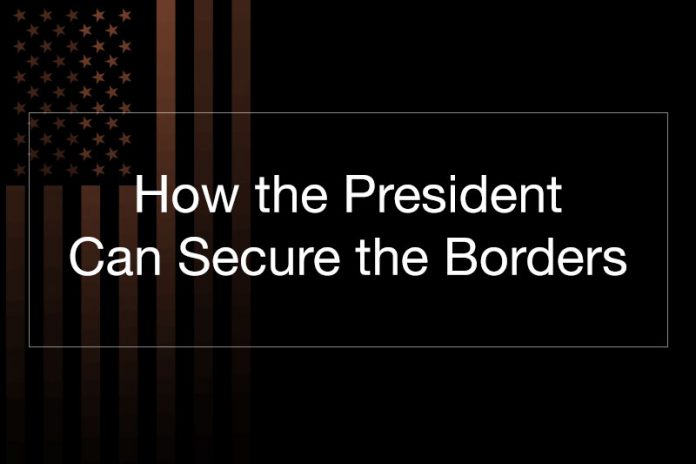Last Updated on July 11, 2022 by Constitutional Militia
With the issue of illegal immigration already coming to the fore in the contest for nomination of the 2016 Republican candidate for the Presidency, the question naturally arises: “How could a new President in 2017 and thereafter use the laws already in existence in order to curb illegal immigration?”
A significant part of the present problem is that the authorities, both within the General Government and the States, do not dispose of enough “boots on the ground” to come close to adequately securing this country’s borders—primarily the border with Mexico—against illegal entry. For dealing with this critical deficiency, a new President would have at least three quite simple but highly effective options—none of which has yet caught the attention of any of the announced candidates for the office. These options, moreover, would not in any sense be “optional”, because Article II, Section 3 of the Constitution imposes on the President the unqualified duty to “take Care that the Laws be faithfully executed”.
1. The President could call forth “the Militia of the several States” under his general statutory authority. Article I, Section 8, Clause 15 of the Constitution mandates that Congress shall “have Power * * * [t]o provide for calling forth the Militia to execute the Laws of the Union”. And, pursuant to that authority, Title 10 of the United States Code, Section 332 provides that
[w]henever the President considers that unlawful obstructions, combinations, or assemblages, or rebellion against the authority of the United States, make it impractical to enforce the laws of the United States in any State by the ordinary course of judicial proceedings, he may call into Federal service such of the militia of any state * * * as he considers necessary to enforce those laws or to suppress the rebellion.
In addition, Title 10 of the United States Code, Section 333 provides that
[t]he President, by using the militia * * * , shall take such measures as he considers necessary to suppress, in a State, any * * * unlawful combination, or conspiracy, if it—
(1) so hinders the execution of the laws of that State, and of the United States within the State, that any part or class of its people is deprived of a right, privilege, or immunity, or protection named in the Constitution and secured by law, and the constituted authorities of that State are unable * * * to protect that right, privilege, or immunity, or to give that protection; or (2) opposes or obstructs the execution of the laws of the United States or impedes the course of justice under those laws.
In large measure, illegal immigration is an on-going, highly organized event of international scope, conducted by “unlawful obstructions, combinations, or assemblages”—all of which constitute “conspirac[ies]”—both domestic and foreign. Furthermore, those individuals who otherwise lawfully reside within the United States while also participating in such “unlawful obstructions, combinations, or assemblages” are engaged in a form of “rebellion against the authority of the United States”.
By definition, illegal immigration into the United States “hinders the execution of the laws of [every] State, and of the United States within [every] State”; and in practice it operates on such a massive scale as thoroughly to defeat such “execution”, and thus “opposes [and] obstructs the execution of the laws of the United States [and] impedes the course of justice under those laws”. When and where successful, illegal immigration denies all persons lawfully resident within the United States “the right[s], privilege[s], or immunit[ies], or protection named in the Constitution and secured by law”: (i) to exercise control over the size and composition of the population of their own States in particular and of the United States in general; (ii) not to be taxed for the support of individuals whose illegal presence within the United States disqualifies them from the receipt of public benefits, but who misappropriate such benefits anyway; and (iii) not to be subjected to crime, disease, overuse of public facilities, and excessive wear and tear on critical infrastructure caused by illegal immigrants. Moreover, as is plainly the situation, “the constituted authorities of th[e] State[s] are unable * * * to protect th[ose] right[s], privilege[s], or immunit[ies], or to give that protection”; and it has become “impractical” even for the General Government “to enforce the laws of the United States [dealing with immigration] in any State by the ordinary course of judicial proceedings”. These dire conditions not simply justify, but demand, Presidential action.
Each year, the President would call forth from each of the several States an average of 1,000 individuals who were then designed as members of the so-called “unorganized militia” under Title 10 of the United States Code, Section 311. (Some States might provide more, some States less, in proportion to their populations.) This would provide the President with a total yearly force of 50,000 Militiamen. These individuals would be selected by the Governors of the several States (the commanders in chief of the States’ “unorganized militia”) according to criteria promulgated by the President as “Commander in Chief * * * of the Militia of the several States, when called into the actual Service of the United States” under Article II, Section 2, Clause 1 of the Constitution, and therefore the “Commander in Chief” of the Governors as well with respect to this matter. These criteria would relate to the Militiamen’s ages, physical condition, education, skills, experience, and other qualifications relevant to the tasks involved in securing the borders against illegal immigration. Because so few Militiamen would be called forth, the Governors would likely be able to rely on large percentages of volunteers. In any event, the Militiamen called forth each year would be divided into two classes of 500 each from each State, or a total of 25,000 in each class. Each class would be required to serve for (say) a period of six months, in rotation, to be replaced at the end of each such term by a new class called forth for that purpose. In keeping with the historically invariable principles of constitutional Militia, each member of the Militia called forth for active service would be required to furnish his own basic equipment (as stipulated by the President), but otherwise would be supplied and adequately compensated for his endeavors at public expense. And all Militiamen would receive expedited, intensive training which would enable them to serve in the field for as much time as possible during their tours of duty. Some 25,000 Militiamen deployed all at once should suffice to seal America’s border with Mexico. (If not, the yearly quota from each of the States could be increased by an increment of 1,000 per year, until the necessary number was reached.)
Financial support of the Militia called forth could be drawn from such moneys as would already have been allocated by the General Government and the States for Militia service out of general tax revenues. But, in keeping with constitutional principles, the necessary funds could also—and should preferably—be drawn from those members of the Militia who, although not called forth for active service in the field, could be called upon to subsidize their fellow Militiamen’s activities, these fees being the quid pro quo for exemptions from active service. A simple example demonstrates the practicality of this approach: In Virginia, the total number of males and females of ages 18 through 45 in households, who would qualify in principle for “the unorganized militia” under 10 U.S.C. § 311, is approximately 2,816,000. Subtracting ten percent of these who would be ineligible for any service due to physical or other disability leaves 2,534,000. Subtracting the 1,000 called forth for active duty leaves 2,533,400. Were each of these remaining individuals required to pay a fee of merely ten dollars for an annual exemption from active duty under the President’s call, the Militia in Virginia would have available a yearly renewable fund of $25,334,000. Allocated amongst those called to active duty, this would provide $25,334 per Militiaman per year—certainly sufficient to support each individual for six months’ active duty in the field.
2. The President could authorize the States to enforce the immigration laws of the United States under statutory authority relating specifically to immigration. The President would not need to take direct command of the Militia which might be called forth to secure the borders and otherwise to police illegal immigrants. Instead, he could act through one of his cabinet officials. Title 8 of the United States Code, Section 1357(g) provides that
(1) * * * the Attorney General [of the United States] may enter into a written agreement with a State, or any political subdivision of a State, pursuant to which an officer or employee of the State or subdivision, who is determined by the Attorney General to be qualified to perform a function of an immigration officer in relation to the investigation, apprehension, or detention of aliens in the United States (including the transportation of such aliens across State lines to detention centers), may carry out such function at the expense of the State or political subdivision and to the extent consistent with State and local law.
(2) An agreement under this subsection shall require that an officer or employee of a State or political subdivision of a State performing a function under the agreement shall have knowledge of, and adhere to, Federal law relating to the function, and shall contain a written certification that the officers or employees performing the function under the agreement have received adequate training regarding the enforcement of relevant Federal immigration laws.
Plainly enough, in addition to the personnel in a State’s regular law- enforcement agencies, the “officers” to which this statute refers could be members of the State’s Militia—and likely would have to be, if such “officers” in sufficient numbers were to be deployed. The necessary “written agreement with a State, or any political subdivision of a State” would simply need to stipulate that individuals from the State’s “unorganized militia” would be called forth, pursuant to the State’s laws, “to perform [the] functions of * * * immigration officer[s]”. And the Attorney General, acting under a directive from the President, could so require. This would then prove to be another instance of Congress’s provision “for calling forth the Militia to execute the Laws of the Union”.
For an example of how this arrangement could operate, in Virginia under Code § 44-8 “[t]he Governor * * * shall have power to employ [the unorganized militia] to repel invasion * * * and enforce the execution of the laws”. Obviously, a “written agreement with [Virginia], or any political subdivision of [Virginia]” would qualify as one of “the laws” to be “execut[ed]”. So, to implement such an agreement, under Code § 44-75.1(A) (3) “[t]he Governor * * * [could] call forth the militia or any part thereof * * * [w]hen the Governor determine[d] that a state agency or agencies having law-enforcement responsibilities [we]re in need of assistance to perform particular law-enforcement functions, which function he shall specify in his call to the militia”. This “determin[ation]” would be made an explicit term in Virginia’s “written agreement” with the Attorney General. In addition, pursuant to Code § 44-78.1, under those circumstances “the governing body or the chief law-enforcement officer of [a] county, city or town [could] call upon the Governor for assistance from the Militia”; and “[t]he Governor [could] call forth the militia or any part thereof to provide such assistance as he may deem proper”—which contingencies could also be included in the agreement. And because Code § 44-80 allows the Governor to call forth individuals from only “the unorganized militia” for these purposes, the agreement could so specify, too.
Thus, overall, the effect of the Attorney General’s and the States’ Governors use of 8 U.S.C. § 1357(g) could be equivalent to the President’s employment of 10 U.S.C. §§ 332 and 333. Use of § 1357(g) would have the additional advantage of maximizing true federalism in the enforcement of this country’s immigration laws.
3. The President could recognize the reserved constitutional authority of the States to defend themselves against invasion by illegal immigrants. Article I, Section 10, Clause 3 of the Constitution reserves to the States the authority, without seeking “the Consent of Congress” (and therefore without being subject to any prohibition or limitation emanating from Congress), to “engage in War” when “actually invaded, or in such imminent Danger as will not admit of delay”. In many (if not all) of the States today, the flood of illegal immigrants amounts to an actual invasion, or presents an imminent danger of that sort which does not admit of delay.
Inasmuch as the States could go to the extreme of employing powers suitable for “engag[ing] in War” to repel such an invasion, they surely could employ less stringent powers for that purpose—including their powers to call forth “the unorganized militia” to enforce their own laws.
Therefore the States could enact laws which would precisely follow the pattern of the General Government’s immigration statutes, except that each of the States would deploy her own Militia to execute those laws within her own territory. The President’s overarching rôle would be to express his recognition of, to encourage, and to provide his Administration’s full support for the States’ exercise of their reserved constitutional authority to take such action, and then not to interfere therewith, so long as the States proceeded against illegal immigration in a manner basically consistent with the General Government’s laws on that subject. By thus promoting the enactment of such State laws, effectively ratifying them, and at least allowing their enforcement (as well as assisting that enforcement whenever possible), the President would render irrelevant the Supreme Court’s largely erroneous decision in Arizona v. United States, 567 U.S. –– (2012). This would offer the added advantage of demonstrating in as clear-cut a fashion as possible the imprudence, the impracticality, and even the imbecility of the Court’s self- proclaimed doctrine of “judicial supremacy”.
©2015 Edwin Vieira, Jr. – All Rights Reserved.



































